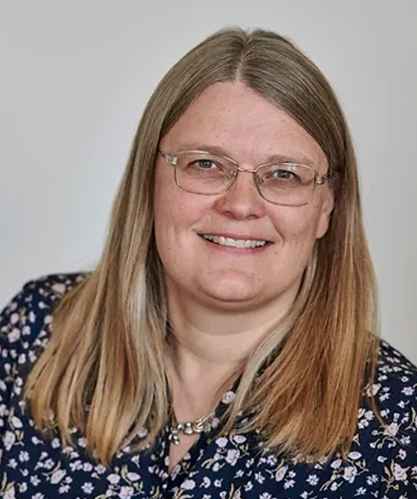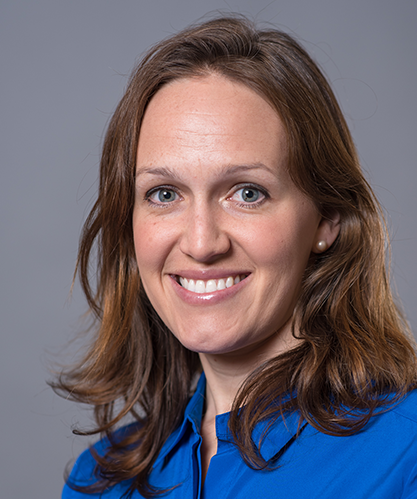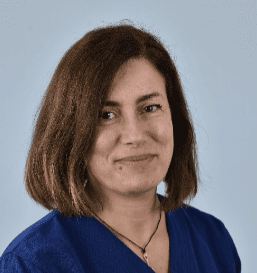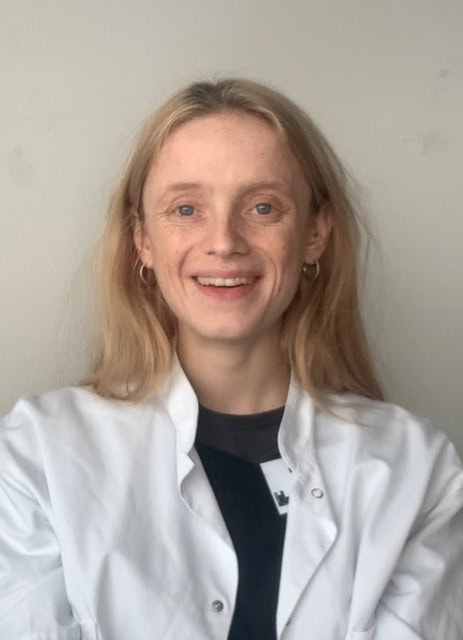
Researchers & Partnerships

Dr. Jing-Qiong (Katty) Kang M.D., Ph.D.
Associate Professor of Neurology
Vanderbilt University Medical Center
The Kang Laboratory is interested in understanding the role of GABAergic signaling in disease conditions as well as in normal brain development. Currently, lab staff members are investigating the molecular pathophysiology of genetic variations in GABAA receptor subunits and two common pediatric syndromes: epilepsy and autism.
https://medschool.vanderbilt.edu/pharmacology/person/katty-kang-m-d-ph-d/

Sara Poliquin
Postdoctoral fellow at COMBINEDBrain
Chief Scientific Officer of Cure GABA-A
Sarah completed her PhD under Dr. Katty Kang, and her work focused on cellular mechanisms of genetic epilepsies caused by mutations in the GABAergic signalling pathway. Sarah primarily studied the GABRG2(Q390X) mutation associated with Dravet syndrome, and the role of protein degradation pathways like autophagy and the ubiquitin-proteasome system in this disease pathophysiology. She has also worked extensively on projects involving SLC6A1-mediated neurodevelopmental disorders, including preclinical research on 4-phenylbutyrate (PBA). Sarah is now a postdoc at COMBINEDBrain and continues to be involved in the GABAergic disease community.

Rikke Steensbjerre Møller
Professor, PhD
Department of Regional Health Research
Coordinative Head of Research, IRS
The Epilepsyhospital Filadelfia
Our team at the Danish Epilepsy Centre are aiming to help improving diagnosis for individuals with severe genetic epilepsy through genetic testing, and to help raising awareness of genetic epilepsies. Making a genetic diagnosis has many implications for management and counseling, and help us to accurately document the natural history of genetic epilepsies. First step towards precision medicine is precision diagnosis!
The overall aim of our research is to unravel the underlying mechanisms of genetic epilepsies, to understand correlations with clinical symptoms and to find new treatment options.
https://portal.findresearcher.sdu.dk/en/persons/rsmoller

Tingwei Mu, PhD
Associate Professor
PhD, Biochemistry
Case Western Reserve University School of MedicineCaltech
California Institute of Technology
Currently, the Mu lab focuses on neurotransmitter-gated ion channels, including gamma-aminobutyric acid type A (GABAA) receptors and N-methyl D-aspartate (NMDA) receptors. They mediate the excitation inhibition balance in the mammalian central nervous systems. Their functional defect leads to epilepsy, autism, intellectual disability, and other neurodevelopmental diseases.

Nathan Absalom, PhD
Lecturer
Western Sydney University, Australia
“Every Story Matters – The Power of Natural History Studies in Rare Diseases”
Dr Absalom is an expert in GABAA receptor structure and function. With a large collaborative team at the University of Sydney, Florey Institute in Melbourne and the Danish Epilepsy Centre, he aims to transform the diagnosis and treatment of genetic epilepsies associated with GABAA receptor variants. By unravelling the mechanisms underlying the unique circumstances of individual patients, he hopes that precision medicine strategies targeting the causes of the disorders can be developed.

Henry Lee, MPhil PhD
Preclinical Scientific Program Manager
Research Associate in Neurology, Harvard Medical School
Dr. Lee is a trained molecular neurobiologist interested in understanding the molecular mechanisms underlying neuronal inhibition, brain plasticity and functional recovery as it pertains to brain development and brain trauma. Dr. Lee combined molecular biology and electrophysiology techniques to discover that phosphorylation-dependent turnover of potassium chloride co-transporter KCC2 controls Cl- mediated GABAergic inhibition (Lee et al., Nat Neurosci, 2011). He also used novel genetic mouse models to dissect a paracrine signaling mechanism underlying critical period (CP) plasticity control (Spatazza, Lee et al., Cell Rep, 2013; Lee et al., Mol Psychiatry, 2017).
Dr. Lee’s translational research included functional recovery after nerve damage (Bei, Lee et al., Cell, 2016) and traumatic brain injury (Hsieh, Lee et al., Cerebral Cortex, 2016). More recently, Dr. Lee focuses on a rare inborn GABA metabolic disorder SSADH deficiency. By developing a SSADHD mouse tool that allows ‘on-demand’ SSADH restoration, Dr. Lee aims to contribute to the preclinical development of novel SSADHD therapies.

Sebastian Ortiz De la Rosa
Pediatric Neurologist / Pediatric Epileptologist
Danish Epilepsy Centre
Sebastian is presently engaged in a comprehensive examination of the phenotypic manifestations observed in individuals possessing GABAAR variants. His aim is to enhance comprehension of the intricate networks and systems implicated in the pathophysiology of these disorders. Additionally, he endeavors to equip clinicians with tools facilitating the early identification of these disorders.
Sebastian is actively engaged in international epilepsy communities, serving as the Chair of the Young Epilepsy Section from International League Against Epilepsy (ILAE) from September 2023 to September 2025. His contributions to various international congresses, including the International Epilepsy Congress and Latin American Epilepsy Congress, reflect his dedication to advancing knowledge in his field.
A multilingual professional, Sebastian is fluent in Portuguese, Spanish, English, and has a basic proficiency in French and Danish. He is a member of prestigious associations such as the Danish Epilepsy Society, International League Against Epilepsy (ILAE), American Academy of Clinical Neurophysiology.

Terry Jo – CombinedBrain
Terry Jo Bichell, PhD, MPH
Terry Jo Bichell is a neuroscientist who earned her PhD because she has an adult son with Angelman syndrome. She founded the Consortium for Outcome Measures and Biomarkers for Neurodevelopmental Disorders (COMBINEDBrain) in 2020 with a mission to speed the path to clinical treatments for people with severe rare genetic neurodevelopmental disorders by pooling efforts, studies and data.

Dr. Anna Pfalzer
Research Assistant Professor
Department of Neurology at Vanderbilt University Medical Center
Dr. Pfalzer is a translational neuroscientist with a primary research focus on understanding the earliest molecular and behavioral changes in monogenic neurological diseases. Her lab’s overall goal is to examine the intersection between neurodevelopment and neurodegeneration in a novel cohort of individuals at-risk for autosomal dominant conditions. Because of her experience in translational neuroscience, she was recently appointed as Chief Scientific Officer for COMBINEDBrain – a Consortium for Outcome Measures and Biomarkers for Neurodevelopmental Disorders. In this role, she assists patient advocacy groups in their mission to develop a cure for children with genetically-driven neurodevelopmental disorders. Dr. Pfalzer has more than 30 peer-reviewed articles, is an editor for several academic journals, and actively participates in several Neurology professional groups throughout the United States. Dr. Pfalzer’s research is supported by private foundations and federal funding sources.

Amber Freed
Founder and CEO of SLC6A1 Connect
Chief Operating Officer of Cure GABA-A
Ms. Freed serves as the Chief Operating Officer of Cure GABA-A.
Ms. Freed served in a variety of equity and financial analysis roles, most recently in consumer equity research with Janus Henderson Investors. Prior to Janus, Ms. Freed was a Vice President with Stout, Risius & Ross in Houston, Texas, focusing on private company and personal valuations. Ms. Freed has also served in roles with RK Capital Management, Dividend Capital Trust, and KPMG LLP. Ms. Freed attended the University of Denver for both undergraduate and graduate school, receiving degrees in Accounting on an academic scholarship.
She was nominated for the Global Genes Rare Champion of Hope Award, is a member of the Rare Advocacy Movement and sits on the Board of CombinedBrain.

Gerry Nesbitt
Gerry Nesbitt, MBM PMP
IT Advisor | Volunteer
Gerry has earned a long-standing and solid reputation in healthcare and clinical research IT/Informatics, showcasing a track record of delivering innovative web-based technology platforms in medical research. From 2007 to 2014, he directed the informatics division for the global Epilepsy Phenome/Genome Project (EPGP), the Human Epilepsy Project (HEP), and Epi4K.
In 2014, Gerry designed and developed CLIRINX, a state-of-the-art web-based data collection system for epilepsy and rare disease clinical research. The CLIRINX system is utilized across multiple global research projects, including those at Lurie Children’s Hospital, Northwestern University, the Baylor College of Medicine, Dravet Foundation, Colorado Children’s Hospital, Emory University/Children’s Healthcare of Atlanta, FamilieSCN2A, University of Melbourne, DEE-P Connections and the SCN8A Alliance. These projects encompass natural history studies, clinical trial readiness studies, patient registries, and clinical systems. Additionally, Gerry serves as a volunteer IT advisor to several parent-led groups.
In 2019, Gerry continued to make significant contributions with the design and launch of the CRID Clinical Research ID. This sophisticated system plays a pivotal role in consistently identifying patients across various research protocols within the realm of rare disease clinical research. Gerry’s professional journey stands as a testament to his unwavering dedication to advancing clinical research through the strategic application of innovative informatics solutions.

Dr. Michael Rogawski
Professor, Department of Neurology
Dr. Michael Rogawski, a professor and physician at UC Davis Health, will explain the Clinical presentation of GABR Variants and current treatments.
He has been elected a fellow of the National Academy of Inventors (NAI), the highest professional distinction for academic inventors. His inventions in drug discovery and development, particularly in the field of neuropharmacology, have led to significant advancements in treating epilepsy and neuropsychiatric conditions.
Dr. Rogawski’s election as an NAI fellow recognizes his prolific spirit of innovation and contributions to improving the quality of life through groundbreaking inventions.
Notable achievements include the development of epilepsy drug perampanel (Fycompa®) and brexanolone (Zulresso™), the first FDA-approved drug for postpartum depression. His work reflects a dedication to translational research and collaboration within the scientific community.

Dr. Elena Gardella
MD, Ph.D., Neurologist and Clinical Neurophysiologist
Elena Gardella, MD, Ph.D., is a neurologist and clinical neurophysiologist with over 25 years of expertise in
research, diagnosis, and treatment of complex epilepsies.
Elena Gardella is a board member of the International League Against Epilepsy (ILAE), a member of the Commission on Classification and Terminology of the ILAE, a member of the steering committee of the Danish Epilepsy Chapter, a member of the Italian Epilepsy Chapter, a member of the American Epilepsy
Society, and a member of EpiCARE, the European Reference Network for rare and complex epilepsies.
Ten years ago, she was appointed associate professor at the University of Southern Denmark and is currently
working at the Department of Clinical Neurophysiology and the Department of Epilepsy Genetics and Personalized Medicine at the Danish Epilepsy Centre “Filadelfia” in Dianalund (DK).
Her principal research fields are deep phenotyping of newly discovered genetic epilepsies, bridging the gap between gene discovery and clinical practice, and putting the basis for personalized counseling and targeted treatment, including new treatment options and identification of electroclinical biomarkers.
In the past few years, her research has been focused on strategies for rare disease registries and natural history studies.

Dr. Kirill Zavalin
Postdoctoral Fellowship at Vanderbilt University
Dr. Kirill Zavalin is a postdoctoral fellow at Vanderbilt University Medical Center, specializing in genetic epilepsy and brain development, particularly focusing on GABAergic neurotransmission. His research investigates rare genetic epilepsies associated with specific gene mutations, employing various techniques such as brain slice electrophysiology and molecular biology. With extensive experience in academic writing, presentations, teaching, and collaboration, Dr. Zavalin is poised to contribute significantly to biomedical neuroscience research, particularly in epilepsy studies.

Dr. Lidong Liu
senior research scientist in the Department of Neurology and the DM Centre for Brain Health at the University of British Columbia
Dr. Lidong Liu, a senior research scientist in the Department of Neurology and the DM Centre for Brain
Health at the University of British Columbia, working with Dr. Yu Tian Wang and mainly focusing on the
molecular mechanisms involved in the modulation of synaptic function and plasticity at both excitatory
and inhibitory synapses under physiological and pathological conditions.
GABA A Receptor is one of our ongoing projects. We identified the first GABRA1 variant (A322D) in
epilepsy patients two decades ago and recently have characterized several other variants and tested a
few repurposing drugs on these variants as per the request of doctors and patients’ families.
We have recently made several new discoveries regarding the functional regulation of GABA A Rs. We
found a physiologically and pathologically significant crosstalk between glutamate and GABA A receptors,
in which glutamate can directly bind to and allosterically potentiate GABA A Rs to homeostatically
counteract glutamate receptor-mediated overexcitation. Knock-In mice with glutamate binding site
mutations in GABA A R shown increased neuronal excitability and seizure susceptibility and also displayed
autistic behavioral phenotypes.
We have also discovered that netrin-1, an axon guidance cue molecule, is secreted and binds to GABA A R
following elevated neuronal excitability, thereby inducing homeostatic upscaling of GABA A R-mediated
synaptic efficacy by increasing the channel conductance.

Aleksandra Foksinska
Program Manager at the UAB Hugh Kaul Precision Medicine Institute
Aleksandra Foksinska is the Program Manager at the UAB Hugh Kaul Precision Medicine Institute. Her background is in Molecular Biology (BS) and Biomedical Sciences (MS) from the University of Alabama at Birmingham. Aleksandra’s research interests include identifying drug repurposing candidates for rare genetic disorders using AI. Aleksandra also serves as a project coordinator for the UAB Center for Precision Animal Modeling, as well as a committee member for the Undiagnosed Diseases Network Therapeutic Matching Committee.

Aleksandra Foksinska
Case Analyst at the UAB Hugh Kaul Precision Medicine Institute
Alexandria Howard is a Case Analyst at the UAB Hugh Kaul Precision Medicine Institute. She is currently approaching her senior year at the University of Alabama at Birmingham with a double major in Genetics/Genomic Sciences and Neuroscience and a minor in Chemistry. Alexandria‘s research interests include investigating various rare genetic disorders and identifying drug repurposing candidates using AI.

Cordelia Katharine Lindhard Smidth
Fifth year medical student from Copenhagen in Denmark.
I am a fifth-year medical student from Copenhagen, Denmark, currently focusing on my master’s thesis in personalized medicine within genetic epilepsy. This research is conducted jointly at The Juliet Knowles Lab at Stanford University and Filadelfia Epilepsy Hospital in Denmark. My career aspiration is to integrate research findings into clinical practice, particularly benefiting children who lack adequate treatment options. Dr. Juliet Knowles and Prof. Rikke Møller supervise my project, which aims to establish a framework linking genetic diagnosis to precise treatments for pediatric genetic epilepsy.
The current landscape shows increasing insights into human genetics, yet the translation of genetic data into actionable patient care concepts lags behind. This gap is influenced by two primary challenges: the variability in clinical outcomes associated with different genetic variants within a single gene, complicating treatment decisions, and the empirical nature of current epilepsy treatments due to the absence of targeted therapies for specific genetic changes.
Our specific focus is on the genetic LOF variant D120N in the GABRB3 gene’s beta-3 subunit, known for severe forms of developmental and epileptic encephalopathy (DEE), such as Lennox Gastaut Syndrome (LGS). This variant’s location in the gene’s extracellular region suggests a correlation with clinical severity based on functional domains. However, understanding which genetic variants correlate with mild or severe presentations remains a challenge, impacting prognostication and treatment strategies. Furthermore, the pathophysiology and underlying cellular mechanisms associated with these genetic variants require further investigation.
Through this research, I aim to contribute to the advancement of personalized medicine, ultimately improving outcomes for children affected by genetic epilepsy.
To address these challenges, our study aims to:
1 – Perform detailed genotype- phenotype correlation of individuals with LOF GABRB3-related
epilepsy
2 – Use single cell transcriptomics to define novel precision therapeutic targets in a mouse
model (Gabrb3+/D120N ) of GABRB3-related early onset epilepsy.

Project FIND-OUT

Coriell Institute For Medical Research NIGMS
Human Genetic Cell Repository
Collection of Cell Line Patnership 2023
The NIGMS Human Genetic Cell Repository, sponsored by the National Institute of General Medical Sciences, provides scientists around the world with resources for cell and genetic research. Established in 1972 at the Coriell Institute for Medical Research, the NIGMS Repository contains more than 11,900 cell lines, primarily fibroblasts and transformed lymphoblasts, and more than 5,900 DNA samples. Currently, the NIGMS HGCR catalog also contains over 85 iPSC lines.
Repository samples represent a variety of disease states, chromosomal abnormalities, apparently healthy individuals, and many distinct human populations. These samples comprise over 1,100 different OMIM diagnoses, and have been referenced in over 6,900 scientific publications.

Ciitizen
Partnered with GABA A Variants 2023

CombinedBrain
Partnered with GABA A Variants 2023
Collection of Cell Line Patnership 2023
The Consortium for Outcome Measures and Biomarkers for Neurodevelopmental Disorders is devoted to speeding the path to clinical treatments for people with severe rare genetic non-verbal neurodevelopmental disorders by pooling efforts, studies and data.

Unite Us
Partnered with GABA A Variants 2023
Unite Us brings together healthcare providers, payers, governments, nonprofits, private-sector entities, and others who are building a world of connected communities to improve people’s health and well-being.
Our cross-sector collaboration software establishes a new standard of care that identifies social needs in communities, manages enrollment of individuals in services, and leverages meaningful outcomes data and analytics to further drive community investment.
From 2013 to today, we’re proud to unlock the potential of communities nationwide.
Families can submit an assistance request form online.

